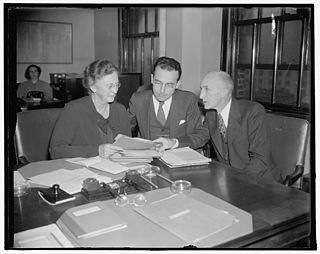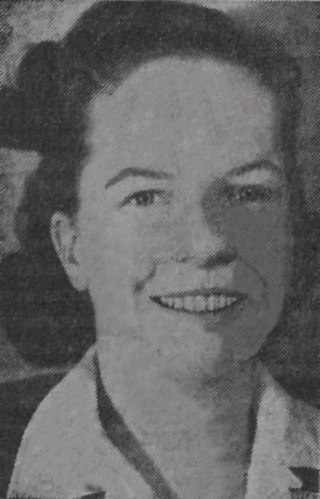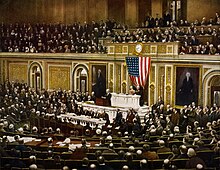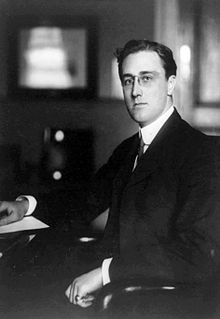A Red Scare is a form of moral panic provoked by fear of the rise, supposed or real, of leftist ideologies in a society, especially communism and socialism. Historically, "red scares" have led to mass political persecution, scapegoating, and the ousting of those in government positions who have had connections with left-wing to far-left ideology. The name is derived from the red flag, a common symbol of communism and socialism.

Felix Frankfurter was an Austrian-born American jurist who served as an Associate Justice of the Supreme Court of the United States from 1939 until 1962, during which he was an advocate of judicial restraint.

The War Industries Board (WIB) was a United States government agency established on July 28, 1917, during World War I, to coordinate the purchase of war supplies between the War Department and the Navy Department. Because the United States Department of Defense would only come into existence in 1947, this was an ad hoc construction to promote cooperation between the Army and the Navy, it was founded by the Council of National Defense. The War Industries Board was preceded by the General Munitions Board —which didn't have the authority it needed and was later strengthened and transformed into the WIB.

The United States Shipping Board (USSB) was established as an emergency agency by the 1916 Shipping Act, on September 7, 1916. The United States Shipping Board's task was to increase the number of US ships supporting the World War I efforts. The program ended on March 2, 1934.

The first Red Scare was a period during the early 20th-century history of the United States marked by a widespread fear of far-left movements, including Bolshevism and anarchism, due to real and imagined events; real events included the Russian 1917 October Revolution, German Revolution of 1918–1919, and anarchist bombings in the U.S. At its height in 1919–1920, concerns over the effects of radical political agitation in American society and the alleged spread of socialism, communism, and anarchism in the American labor movement fueled a general sense of concern.

Arthur Joseph Altmeyer was the first United States Commissioner for Social Security from 1946 to 1953, and the second chairman of the Social Security Board from 1937 to 1946. He was a key figure in the design and implementation of the U.S. Social Security system.

The United States Women's Bureau (WB) is an agency of the United States government within the United States Department of Labor. The Women's Bureau works to create parity for women in the labor force by conducting research and policy analysis, to inform and promote policy change, and to increase public awareness and education.

The Information Security Oversight Office (ISOO) is responsible to the President for policy and oversight of the government-wide security classification system and the National Industrial Security Program in the United States. The ISOO is a component of the National Archives and Records Administration (NARA) and receives policy and program guidance from the National Security Council (NSC).

The Office of Alien Property Custodian was an office within the government of the United States during World War I and again during World War II, serving as a custodian to property that belonged to US enemies. The office was created in 1917 by Executive Order 2729-A under the Trading with the Enemy Act of 1917 (TWEA) in order to "assume control and dispose of enemy-owned property in the United States and its possessions."

Max Lowenthal (1888–1971) was a Washington, DC, political figure in all three branches of the federal government in the 1930s and 1940s, during which time he was closely associated with the rising career of Harry S. Truman; he served under Oscar R. Ewing on an "unofficial policy group" within the Truman administration (1947–1952).

The Depression of 1920–1921 was a sharp deflationary recession in the United States, United Kingdom and other countries, beginning 14 months after the end of World War I. It lasted from January 1920 to July 1921. The extent of the deflation was not only large, but large relative to the accompanying decline in real product.

During World War I, the United States saw a systematic mobilization of the country's entire population and economy to produce the soldiers, food supplies, ammunitions and money necessary to win the war. Although the United States entered the war in April 1917, there had been very little planning, or even recognition of the problems that Great Britain and the other Allies had to solve on their own home fronts. As a result, the level of confusion was high in the first 12 months.

The United States declared war on the German Empire on April 6, 1917, nearly three years after World War I started. A ceasefire and armistice were declared on November 11, 1918. Before entering the war, the U.S. had remained neutral, though it had been an important supplier to the United Kingdom, France, and the other powers of the Allies of World War I.

Walter Edward Weyl was a writer and speaker, an intellectual leader of the Progressive movement in the United States. As a strong nationalist, his goal was to remedy the relatively weak American national institutions with a strong state. Weyl wrote widely on issues of economics, labor, public policy, and international affairs in numerous books, articles, and editorials; he was a coeditor of the highly influential The New Republic magazine, 1914–1916. His most influential book, The New Democracy (1912) was a classic statement of democratic meliorism, revealing his path to a future of progress and modernization based on middle class values, aspirations and brain work. It articulated the general mood:

World War I marked the first war in which American women were allowed to enlist in the armed forces. While thousands of women did join branches of the army in an official capacity, receiving veterans status and benefits after the war's close, the majority of female involvement was done through voluntary organizations of the war effort or through becoming a nurse for the military. Additionally, women made an impact on the war indirectly by filling the workforce, becoming employed in the jobs left behind by male soldiers.
Paul Frederick Brissenden was an American labor historian who wrote on various labor issues in the first half of the 20th century. He is perhaps best known for his 1919 work on the Industrial Workers of the World, entitled The IWW: a Study of American Syndicalism.

Mary Abby van Kleeck was an American social scientist of the 20th century. She was a notable figure in the American labor movement as well as a proponent of scientific management and a planned economy.
Nathan Ross Margold was a Romanian-born American lawyer. He was a municipal judge in Washington, D.C., and the author of the 1933 Margold Report to promote civil rights for African-Americans through the courts. He was also a supporter of Native American civil rights and Native American sovereignty. In addition to his legal career, Margold is remembered as the father of adult film pioneer William Margold.
George Shaw Wheeler was an American economist and advisor to President Franklin Delano Roosevelt, best known for being the first American to defect over the Iron Curtain to Czechoslovakia in November 1947.

Frances Wheeler Sayler was an American civil rights and labor activist. She worked in the La Follette Committee and for the United States Women's Bureau, before became an organizer in the United Electrical, Radio and Machine Workers of America union. She was active in the early civil rights movement, fighting to desegregate facilities and abolish the poll tax.



















